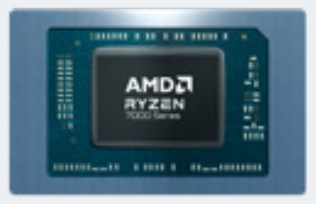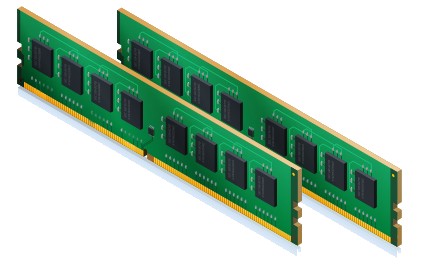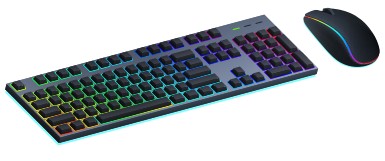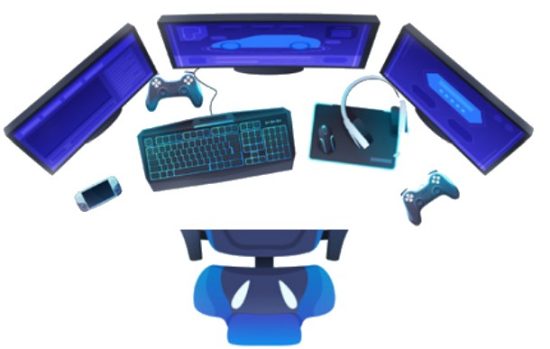
 The Ultimate Guide to Building a Gaming Development PC:
The Ultimate Guide to Building a Gaming Development PC:
NEXT-GEN HARDWARE AND
FUTUREPROOF STRATEGIES 
INTRODUCTION
From asset creation and real-time rendering to testing and live deployment, modern game development demands serious hardware. The global gaming industry—now a $257 billion market and projected to nearly triple by 2032— isn’t just defined by players anymore. Behind every smooth frame and immersive world is a developer pushing tech to its limits.
Whether you’re an indie developer working solo or an IT lead sourcing hardware for a multi-discipline studio, building the right workstation or test rig is critical. You need systems that can handle complex physics simulations, compile massive codebases, run virtual machines for QA, and push high-res environments in-engine.
This guide is your technical roadmap to building powerful, future-ready systems for game development, testing, and live gameplay optimization.
We’ll walk you through the core components—what they do, how they scale, and what to look for based on your team’s needs. From CPU-GPU pairings and memory configurations to network readiness and emerging tech, we’ll help you build with confidence, clarity, and longevity in mind.
Whether you’re launching your next title, testing VR builds across resolutions, or preparing for hybrid workflows, this guide is for you.

THE CORE COMPONENTS: CPU AND GPU
When it comes to game development, your workstation isn’t just for play—it’s your production pipeline. Whether you’re compiling massive builds, managing real-time simulations, or testing across multiple environments, performance and reliability are non-negotiable. At the center of that performance is your CPU and GPU.
These two components determine how fast you can iterate, how smooth your preview runs, and how futureproof your system is for evolving game tech.
Choosing the Right CPU
- AMD Ryzen™ Series (7000 series and up)
Ideal for multi-threaded tasks such as compiling code, running background services, virtualizing test environments, or streaming while developing. More cores and threads per dollar make Ryzen” particularly efficient for parallel workflows.
- Intel® Core™ Series (13th / 14th Gen)
Known for high single-core performance, which benefits engine-heavy tasks, emulation testing, and scenarios where legacy or single-threaded tools are involved. Intel® chips are a good fit for developers working with CPU-intensive physics engines or optimization tools. Choose AMD if you need a workstation that can multitask across IDEs, simulation tools, compilers, and game engines without slowdowns.
Choose AMD if you need a workstation that can multitask across IDEs, simulation tools, compilers, and game engines without slowdowns.
Choose Intel® if you’re optimizing for thread effciency in CPU-bound tasks or working in environments where single-core performance is critical.
Choosing the Right GPU - NVIDIA® (RTX 30/40 Series)
Ideal for developers working with ray tracing, DLSS integration, Al-enhanced workflows (e.g., upscaling, performance testing), or those building in visually demanding 3D environments. NVIDIA®’s driver stability and CUDA support also make it a go-to for studios doing machine learning or simulation work alongside game dev.
- AMD (RX 7000 Series)
Offers strong price-to-performance in the mid-to-high range, making it a solid choice for teams that need multiple testing rigs. Great for rendering assets at 1080p/1440p and supporting VR builds without excessive budget spend.
Choose NVIDIA® if you’re building AAA-level visuals, developing with ray tracing, or need access to CUDA” for cross-functional dev work.
Choose AMD if you’re developing mid-tier titles, VR experiences, or optimizing for high performance at scale without overspending.
CORE COMPONENT RECOMMENDATIONS BY USE CASE
| Use Case | Recommended CPU | Recommended GPU |
| Asset creation + 1080p testing | AMD Ryzen™ 5/Intel® i5 | AMD Radeon™ RX660/NVIDIA® RTX™ 3060 |
| Multi-engine development | AMD Ryzen™ 7/Intel® i7 | NVIDIA RTX™ 7800 XT / NVIDIA RTX 4070 |
| QA testing at multiple resolutions | AMD Ryzen™ 7/Intel® 17 | NVIDIA RTX™ 4070+ or AMD Radeon™ RX 7800 XT |
| Streaming builds, test +PBS | AMD Ryzen™ 9/Intel® 19 | NVIDIA RTX™ 4080+ or AMD Radeon™ RX 7900 XTX |
| Cinematic cutscene rendering / VR dev | AMD Ryzen™ 9/Intel® i9 | NVIDIA® RTX™ 4080/4090 or AMD Radeon™ RX 7900 XTX |
| Cost-effective team scaling | AMD Ryzen™ 5/Intel® i5 | AMD Radeon™ RX 7600/NVIDIA RTX™ 2060 Ti |
RAM AND STORAGE
From compiling code and rendering assets to running multiple applications in tandem, choosing the right RAM and storage strategy ensures your team stays productive and responsive at every stage.
How Much RAM Do You Need for Game Development?
32GB is the new baseline for most development environments. It ensures smooth performance when working across:
- Game engines (Unreal Engine, Unity)
- IDEs, simulators, and emulators
- Browser-based tools, video calls, and local test builds
- Real-time asset previews, audio software, or level editors
64GB+ is recommended for:
- Large-scale asset rendering and scene-building
- Virtual machines or multi-platform test setups
- Multi-threaded compilation or CI pipelines running locally
- Teams working in high-resolution VR / XR development
Choose 32GB if you’re developing standard PC / console titles and running a full suite of creative and debugging tools concurrently.
Choose 64GB+ if your studio is managing large projects, supporting cross-platform builds, or working in graphically demanding environments like photogrammetry, cinematic rendering, or simulation-heavy gameplay.
Storage Strategy: Prioritize Speed and Capacity
Speed and reliability matter in a production pipeline where time equals money. Slow load times or asset access bottlenecks can derail progress, especially when working in large source control repositories or moving multi-GB builds.
- NVMe SSD (PCIe Gen 4 or 5):
The gold standard for development machines. Lightning-fast read / write speeds are ideal for game engines, local build directories, and high-frequency file access. - SATA SSD:
Still useful for secondary tasks—build backups, version systems, or store tools that don’t require NVMe-level speed. - HDD (Hard Disk Drive):
Only suitable for cold storage, large archive libraries, or asset repositories that aren’t accessed daily.
PRO TIP:
Always install your operating system, version control workspace, and active project files on an NVMe SSD to minimize latency during project load, testing, and build.
HARDWARE RECOMMENDATIONS BY USE CASE
| Use Case | Recommended RAM | Recommended Strategy |
| Engine-based development (Unity, Unreal) | 32GB DDR5 | 1TB NVMe SSD for active dev, 1TB SATA SSD for tools |
| Cross-platform testing / simulation | 64GB DDR5 | 2TB NVMe SSD + external or network HDD |
| Content creation / cinematic work | 64–128GB DDR5 | 2TB NVMe SSD + 4TB external RAID |
| VR / XR development | 64GB DDR5 | 2TB PCIe Gen 4 NVMe SSD + expansion slot for future upgrades |
| Budget-friendly dev / test rigs | 32GB DDR4 | 1TB SATA SSD or hybrid SATA + NVMe (OS only) |
MOTHERBOARD
The right board ensures smooth integration between critical components, supports future upgrades without costly rebuilds, and helps maintain stability during long, intensive work sessions like overnight rendering or multi-hour test cycles. Whether you’re outfitting a single high-performance workstation or building a fleet of scalable dev / test rigs, here’s what to look for.

Key Motherboard Considerations for Developers
CPU Compatibility
Match the socket (e.g., AM5 for AMD Ryzen™ 7000 series, LGA1700 for Intel 13th / 14th Gen) and chipset to your preferred processor line. Consider platform longevity—some sockets support multiple generations of CPUs, helping reduce upgrade costs.
RAM Support®
Look for DDR5 compatibility and high-speed memory support for bandwidth-intensive workflows (real-time editing, simulations, streaming engine previews). Ensure enough DIMM slots for future capacity expansion—especially if moving to 64GB+ down the line.
PCIe Slot Support
PCIe 4.0 is becoming the new standard, but PCIe 5.0 compatibility offers headroom for emerging GPU and NVMe SSD requirements. This is essential for developers to build or test games with high I/O loads or advanced graphics features like ray tracing or procedural generation.
Connectivity and Expansion Features
- M.2 slots for NVMe SSDs (at least two for active projects + cache)
- USB-C, Thunderbolt, and USB 3.2 Gen 2 ports for modern peripherals and external storage
- Wi-Fi 6 / Bluetooth 5.2 for wireless development tools, testing on mobile devices, or networked peripherals
PRO TIP:
Prioritize boards with robust VRMs (Voltage Regulator Modules) if you’re using high-wattage CPUs or plan to overclock—especially in content creation or performance testing scenarios.
RECOMMENDED MOTHERBOARD PLATFORMS BY GOAL OR WORKFLOW
| Goal / Workflow | Recommended Chipset | Key Features to Look for |
| Entry-level dev / test rigs | AMD B550 / Intel® B660 | PCIe 4.0, basic VRMs, DDR4 |
| Mid-tier workstations (engine dev, QA) | AMD B650 / Intel® B760 | DDR5 support, multiple M.2 slots, Wi-Fi |
| High-end builds (VR dev, cinematic workflows) | AMD X670 / Intel® Z790 | PCIe 5.0, strong VRMs, Thunderbolt / USB-C |
| Long-term scalability and upgrades | AM5 or LGA 1700 platforms | Multi-gen CPU support, DDR5, PCIe 5.0, extensive I/O |
POWER SUPPLY
Whether you’re compiling builds, running real-time engine previews, or powering multiple high-draw GPUs in a workstation or dev cluster, your PSU determines how reliably and efficiently your system performs. Choosing the right power supply ensures system uptime, protects sensitive components during power fluctuations, and allows for seamless future expansion.
What to Consider in a PSU
Wattage Capacity
Calculate your full system power draw based on CPU, GPU, RAM, and storage usage—and then add 15–25% headroom for future component upgrades or power spikes under load. For devs using workstation GPUs or multiple drives, this margin is critical.
Efficiency Rating (80 PLUS Certified)
Efficiency matters in professional environments where machines may run for hours—or days—on end. Look for:
- 80+ Gold or better for main workstations
- Platinum for content creation or rendering rigs that need long term thermal / power efficiency
- Bronze only for non-critical test systems or entry-level hardware
PRO TIP:
Avoid mixing high-end GPUs with low-tier PSUs, even if wattage seems sufficient. Poor voltage regulation can destabilize sensitive rendering or debugging workflows—especially during live testing.
Modularity
A clean and maintainable case layout supports better thermals and faster servicing.
- Fully modular: Ideal for pro builds; great airflow and easy cable management
- Semi-modular: Balanced choice for test stations or tight IT budgets
- Non-modular: Acceptable only in budget test bench builds or fixed environments
Reliability and Vendor Support
Stick with enterprise-grade or studio-proven brands like Seasonic,
Corsair, EVGA, or Super Flower. Look for units with:
- Long warranties (5–10 years)
- Proven low failure rates
- Flat or braided cables for better airflow
POWER SUPPLY RECOMMENDATIONS BY USE CASE OR SYSTEM ROLE
| Use case / System Role | PSU Wattage Range | Notes |
| Basic test station or IT setup | 450-550W | 80+ Bronze is acceptable for limited use |
| Mid-range dev rig (e.g., RTX™ 4060/4070, Ryzen 7/Intel i7) | 600-750W | 80+ Gold preferred for efficiency and quiet operation |
| High-end asset creation / rendering (RTX 4080+/7900 XTX) | 850-1000W | Fully modular, ensures clean build and future GPU upgrades |
| Studio flagship build or overclocked test bench | 1000-1200W | Plan for overclocking, custom cooling, or multi-GPU use |
COOLING SOLUTIONS
High core utilization, sustained GPU loads, and multitasking across IDEs and design tools generate serious heat.
Effective cooling isn’t just about performance—it’s about ensuring stability, reducing thermal throttling, and preservingcomponent health during long work sessions, automated builds, or collaborative debugging. Air Cooling
Air Cooling
Best for mid-range workstations, dev test rigs, and environments where ease of setup and longevity matter.
Advantages:
- Fewer mechanical failure points than liquid systems
- Easier to replace and maintain (especially at scale)
- Tower-style coolers with large heatsinks and dual 120–140mm fans offer excellent thermal performance for most workloads
Choose air cooling if you’re outfitting development stations that run 1080p / 1440p engines, compiling builds with moderate CPU / GPU loads, or need reliable cooling in shared or hot-swappable environments.
Liquid Cooling
Best for high-end workstations, content creation, multi-threaded rendering, or overclocked test rigs.
Types:
- All-in-one coolers: Closed-loop, compact, and ideal for modern studio setups where quiet operation and space-saving matter.
- Custom loops: High-end option for specialized rigs (multi-GPU systems, showpiece setups, or thermal-intensive testing)
Advantages:
- Superior thermal performance under sustained load
- Quieter operation, especially at high CPU / GPU utilization
- Cleaner internal layout for compact or showcase builds
Choose liquid cooling if you’re compiling massive codebases, working in photorealistic engines like Unreal 5, rendering in Blender / Maya, or running overclocked CPUs for faster simulation or test passes.
PRO TIP:
Prioritize dust filtration and regular maintenance. Thermal performance drops significantly over time due to buildup. Also, position intake / exhaust fans for optimal airflow, especially in compact cases or rooms with multiple workstations. Monitor temps using hardware management tools or software dashboards for proactive issue detection.
COOLING RECOMMENDATIONS BY USE CASE OR WORKSTATION ROLE
| Use Case / Workstation Role | Recommended Cooling | Tips |
| Entry-level dev / test build | Stock air cooler or entry-level tower cooler | Ensure good airflow (2–3 case fans minimum) |
| Standard engine development (Unity / Unreal) | Premium air cooler or 240mm AIO | Optimize case airflow front-to-back |
| Cinematic rendering / VR dev | 280–360mm AIO or custom loop | Use thermal monitoring to detect bottlenecks |
| Compact form factor (mini-iTX) | Low-profile air or 1200mm AIO | Prioritize airflow design due to space limits |
| Overclocked bench / test stations | High-end AIO or custom loop | Ensure PSU + case support for thermal capacity |
DISPLAY MATTERS: CHOOSING THE RIGHT MONITOR
Display selection impacts everything from real-time asset previews and UI layout to cinematic rendering reviews and QA across resolutions. Whether you’re designing environments, debugging animation pipelines, or simulating gameplay on multiple screens, the right monitor is a critical part of your toolkit. Check out our Monitor Buying Guide to explore types of features to make the right selection for your needs.

Resolution and Screen Size
- 1080p (Full HD): Still a key resolution for compatibility testing and development of games targeting mid-range or mobile hardware.
Also suitable for secondary displays (tool panels, documentation, and browser windows). - 1440p (Quad HD): Ideal for most development workflows— balances clarity, performance, and screen real estate for editors, game engines, and visual tools.
- 4K (Ultra HD): Critical for cinematic work, high-res asset review, or dev targeting modern consoles and next-gen displays. Demands a strong GPU, especially in real-time engines.
Screen Size Recommendations
- 27″ is ideal for 1440p / 4K clarity in tight desk setups.
- 32″+ or Ultrawide (21:9 or 32:9) offers better workspace for multitasking, timeline work, or immersive previews.
- Dual / multi-display setups are recommended for devs juggling editors, preview windows, and debugging tools.
Refresh Rate and Response Time
- 60–75Hz: Suitable for general development, asset work, and non-interactive tools.
- 120–165Hz+: Ideal for devs working in real-time engines (Unity / Unreal), especially with FPS, racing, or action titles.
- 1–5ms response times help with motion clarity during preview testing, especially in genres requiring input precision.
PRO TIP:
For QA testers or gameplay engineers focused on animation smoothing, frame timing, or user experience, a high refresh rate display is more than a luxury—it’s a development necessity.
Adaptive Sync: G-Sync vs FreeSync
- G-Sync (NVIDIA® ): Highend, certified monitors that eliminate screen tearing—best for NVIDIA® -focused workflows and advanced debugging.
- FreeSync (AMD): More widely available and cost-effective— compatible with AMD and many NVIDIA® GPUs (G-Sync compatible).
PRO TIP:
Enable adaptive sync during performance QA, especially when testing frame delivery, motion blur, or input lag under varying loads.
MONITOR RECOMMENDATIONS BY ROLE OR USE CASE
| Role / Use Case | Resolution and Size | Refresh Rate | Response Time | Panel Type | Why This works |
| General dev workstation | 1440p, 27″ | 75–120Hz | ≤5ms | IPS | Clear visuals for IDEs, engines, and previews |
| Asset creation /VFX | 4K, 27–32″ | 60–120Hz | 4ms | IPS | High color fidelity,excellent clarity |
| Gameplay and performance QA | 1080p–1440p, 24–27″ | 144–240Hz | 1ms | TN or Fast IPS | Fast response, smooth playback |
| Console /TV platform dev | 4K, 32″, or TV-scale | 60Hz | 4ms | VA or IPS | True-to-device testing fidelity |
| Mobile / responsive layout testing | 1080p, 21–24″ | 60-75Hz | 4ms | IPS | Accurate scaling and portability simulation |
| Multi-tool setups | Dual 27″ 1440p or ultrawide | 75Hz | 4ms | IPS or VA | Workflow efficiency for multitasking |
PERIPHERALS THAT MAKE A DIFFERENCE
From programming and modeling to collaborative testing and playtesting, the right peripherals enhance efficiency, reduce fatigue, and bring clarity to every click, keypress, and callout.

Keyboards
In a studio setting, a keyboard isn’t just a gaming peripheral—it’s a core input device used for development, scripting, and tool control.
Mechanical vs. Membrane
Mechanical keyboards offer tactile feedback, faster actuation, and long-term durability—ideal for long coding sessions, level editing, or rapid input testing.
Membrane keyboards may still appeal for quiet shared workspaces or mobile dev kits.
Switch Types
- Blue switches: Clicky and tactile—great for typing but loud.
- Red switches: Smooth and linear—good for quiet dev work or animation controls.
- Brown switches: Balanced—tactile but quieter, ideal for mixed use.
Recommended Features
- Macro support for automating build commands or repetitive QA tasks
- Hot-swappable switches for studios with shared workstations or dev preferences
- Wired connections preferred for zero latency and long-term stability
Mice
Developers working in engines, design tools, or animation suites need mice that support precision and long-term comfort—not just high DPI for aim training.
Key Considerations:
- Custom DPI settings for switching between pixel-perfect art tasks and fast UI navigation
- Ergonomic design to reduce strain during extended work sessions
- Programmable side buttons for triggering dev tools, running scripts, or switching environments
- Wired mice offer zero-lag precision for input testing, while modern wireless mice with low-latency modes are viable for most workflows
PRO TIP:
Artists and UX testers often prefer a vertical mouse or trackball to reduce wrist fatigue during detailed work.
From programming and modeling to collaborative testing and playtesting, the right peripherals enhance efficiency, reduce fatigue, and bring clarity to every click, keypress, and callout.
Headsets
In hybrid or remote development environments, a good headset is your collaboration lifeline.
- Audio Quality: Crystal-clear sound helps during audio QA, level ambiance reviews, and immersive testing.
- Mic Quality: Prioritize noise-canceling, broadcast-grade mics for team meetings, sprint reviews, and multiplayer test coordination.
- Alternative Setup: Pair studio monitor headphones (e.g., Sennheiser, Audio-Technica) with a dedicated USB / XLR mic (like the Blue Yeti or Shure MV7) for professional-grade audio capture in voiceover or stream content development.
Controllers and Specialized Peripherals
- Controllers
Microsoft Xbox and Sony PlayStation gamepads are essential for input mapping, gameplay QA, and multi-platform development.
Many devs keep both on hand for cross-platform testing. - Testing Tools
- Stream decks for running macros, triggering test states, or controlling capture software
- Flight sticks, racing wheels, or VR controllers for testing niche gameplay features or sim titles
- Customizable keypads for developers working in complex UIs (Blender, Unreal, Maya)

NETWORKING
Whether you’re syncing with version control, downloading build updates, or testing real-time multiplayer, a stable and fast network is essential.

Wired vs. Wireless
- Wired (Ethernet):
Always preferred in dev environments for:- Lower latency
- Fewer interruptions during large file transfers
- Consistent performance in source control syncing or online testing
- Wi-Fi Tips:
- Use Wi-Fi 6 / 6E routers to reduce congestion
- Stick to the 5GHz band for faster speeds and reduced interference
- Ensure routers support QoS (Quality of Service) for prioritizing dev traffic (builds, asset sync, and test environments)
Latency, Jitter, and Online Testing
- Ping under 30ms is ideal when testing online features
- Use dedicated lines or studio network slices to isolate testing traffic from general office or home bandwidth
- Regularly test with VPNs or proxies to simulate global player experiences
Cloud and Remote Collaboration
For cloud-based tools (e.g., Perforce, GitHub, Unity Collaborate, remote rendering), ensure:
- Upload speeds meet sync requirements (especially for large asset libraries)
- Low jitter to prevent dropped packets during file transfers or live debugging
- Use wired backup solutions for critical deployments or demo sessions
FUTURE TECH
From AI-powered pipelines to mixed-reality platforms, the next generation of gear isn’t just about player immersion, it’s reshaping how games are designed, tested, and delivered. For studios and developers looking to stay competitive, here’s a glimpse of what’s coming and how it may impact your stack.
AI-powered Development and Performance Optimization
AI is rapidly becoming an asset in the development pipeline, not just a gameplay feature. Today’s tools can:
- Optimize builds and runtime performance by adjusting settings in real time (DLSS, FSR, frame generation)
- Assist in asset generation (textures, animations, voiceovers) through generative models
- Improve QA via behavior analysis, automated bug detection, and gameplay telemetry
Key Developer Tools
- NVIDIA® DLSS / Frame generation: Real-time upscaling for smoother test experiences without maxing out GPUs
- AI-assisted IDEs (e.g., GitHub Copilot, Replit): Helpful for code suggestions and refactoring
- Unity Muse / UE5 MetaHuman Animator: Accelerating content creation via AI-driven motion and text-to-animation features
Haptic Feedback and Immersive Development
For studios building next-gen experiences—especially in VR, XR, or sim genres—immersive tech is becoming more than a novelty:
- Haptic development kits (vests, gloves, suits) allow teams to prototype and test feedback mechanics with real-world nuance.
- 3D spatial audio and immersive sound engines are influencing level design and multiplayer audio logic.
- Studios working on accessibility and multi-sensory gameplay will increasingly integrate tactile and directional feedback systems into their design and QA workflows.

From AI-powered pipelines to mixed-reality platforms, the next generation of gear isn’t just about player immersion, it’s reshaping how games are designed, tested, and delivered. For studios and developers looking to stay competitive, here’s a glimpse of what’s coming and how it may impact your stack.
VR, AR, and XR: Development-ready,Not Just Experimental
Extended reality tech has matured—and it’s redefining how dev teams approach interaction design, storytelling, and cross-platform testing.
- Standalone headsets like Meta Quest 3 simplify testing in untethered environments—great for mobile or location-based games.
- Tethered setups (Valve Index, Varjo, Apple Vision Pro) offer higher fidelity for AAA XR projects or architectural visualization.
- Cross-platform support (e.g., OpenXR) is improving integration between headsets and engines like Unity and Unreal.
TIP FOR STUDIOS:
Futureproof your development environment with systems that support high-resolution VR rendering and input simulation (including eye tracking, gesture control, and passthrough modes).
Next-gen Displays and Input Gear
- OLED and mini-LED displays now offer ultra-low latency with exceptional color reproduction—perfect for cinematic editing, UI / UX polish, and accessibility testing.
- 240Hz+ refresh rates are becoming important not just for players, but also for QA teams reviewing frame timing, input delay, or animation sync at speed.
- Modular, hot-swappable keyboards and adaptive controllers support accessibility testing, user research, and customizable dev environments.
Eco-conscious and Modular Builds
Sustainability is rising in importance—especially for studios managing hardware at scale or across remote teams.
- Modular components (e.g., GPUs with swappable cooling, SSDs with standardized NVMe layouts) reduce upgrade costs and downtime.
- Energy-efficient parts help reduce heat and power draw—ideal for workstations running around the clock.
- Vendors offering take-back/recycling programs make it easier for IT managers to manage refresh cycles responsibly.
LEVEL UP YOUR DEVELOPMENT ENVIRONMENT
There’s no universal setup for game development—and that’s a strength. The best systems are built with balance: reliable components, smart thermal design, and displays and peripherals that enhance focus and productivity. Whether you’re building, testing, or scaling across teams, your hardware should evolve with your workflow—not hold it back.
Use this guide to plan with purpose, invest where it counts, and futureproof where it matters. Build smart. Iterate fast.
1.800.800.0014
www.connection.com/gaming-technology

 1.800.800.0014
1.800.800.0014
www.connection.com
Documents / Resources
 |
FUTUREPROOF Building a Gaming Development PC [pdf] User Guide Building a Gaming Development PC, Gaming Development PC, Development PC, PC |